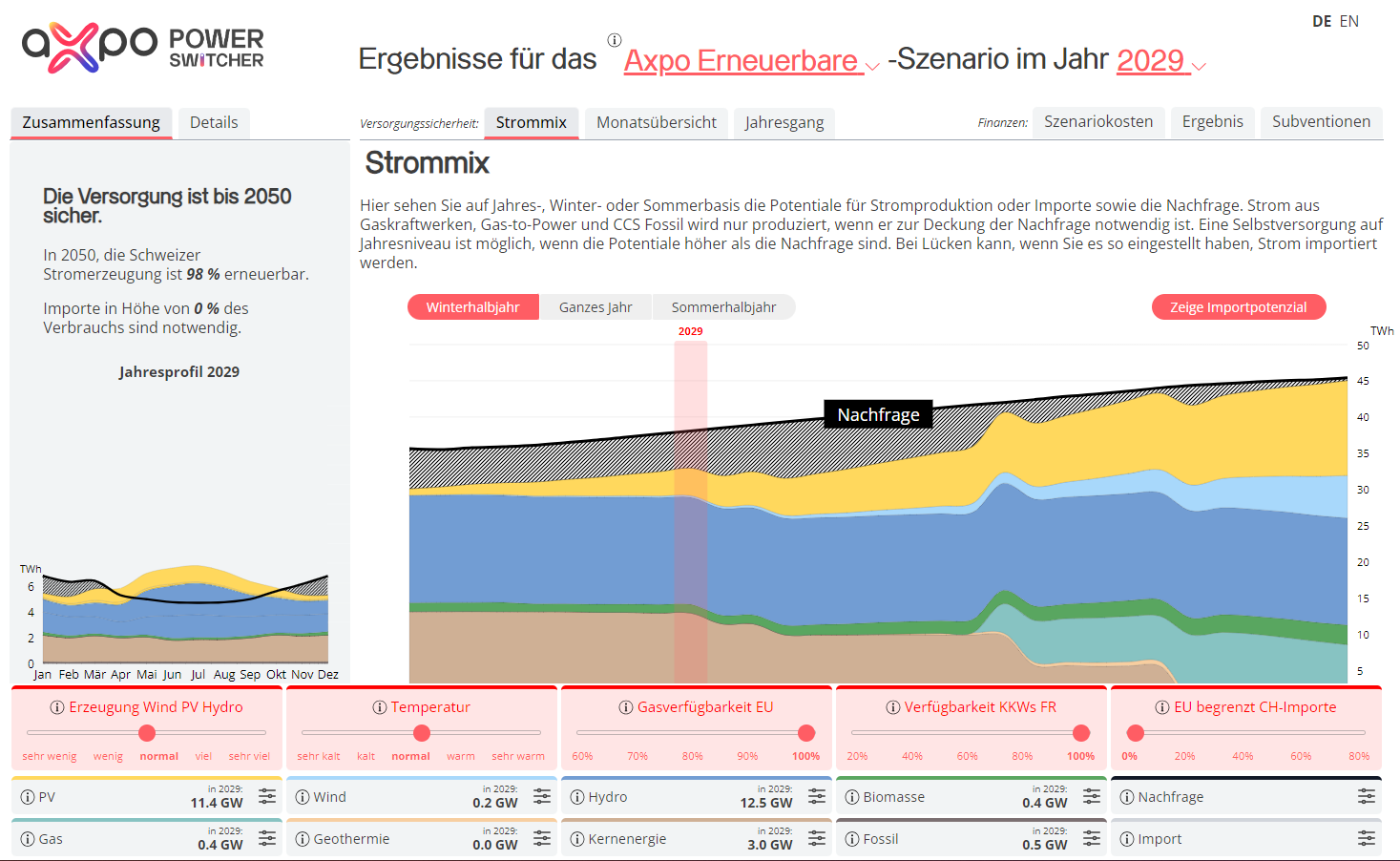05.12.2024 | Stronger fluctuations in the grid
Price increases in the control energy market – the background
The demand for control energy to ensure system stability has increased substantially in recent years. Swissgrid’s strong demand for control energy has also caused prices to rise. This has led to discussions about the introduction of a price cap in the control energy market. How can this high demand and the associated cost increases be explained? The drivers behind this development are the higher fluctuations in the power grid in connection with the expansion of solar energy.
What is control energy?
In order for the power grid to be stable, electricity production and electricity consumption must match at all times. All suppliers and their balancing groups are therefore obliged to purchase or to produce sufficient electricity to cover their allocated consumption. They need to be “balanced” on a quarter-hourly basis. If there are imbalances, for example due to forecasting inaccuracies or short-term outages, the transmission grid operator Swissgrid steps in and closes the gap with what is known as ‘control energy’. Swissgrid then calls off flexible power plants, whose energy it buys through auctions. The costs incurred with the call-offs are passed on to the imbalanced balancing groups (“balancing energy costs”).
Various different control energy products exist. One of the most sophisticated is the secondary control energy, where providers increase or reduce their production at four-second intervals.
Expansion of solar energy as a cost driver
In recent years, the fluctuations in the system and the extent to which Swissgrid needs to provide control energy have increased sharply. The background is the massive expansion of solar power plants whose electricity production depends on changing weather conditions. On 22 April 2024, for example, Swissgrid had to intervene with 1.4 GW, i.e. more than the output of a Swiss nuclear power plant. This was due to considerable deviations from the forecasts in solar production. Such massive corrections mean that Swissgrid has a very high demand for control energy. To ensure the necessary control energy, Swissgrid is dependent not only on hydropower plants, but also on consumers and small producers aggregated via flexpools. Providers who are contracted by Swissgrid by auction need to be prepared for call-offs, some of which are very unlikely, and forego other market opportunities. In addition, certain smaller providers, such as consumers, often have very high costs in the case of activation. As in all other markets, a rising supply curve is emerging. This means that the greater the quantity of control energy required by Swissgrid, the higher the price. The price increase is most evident in the case of secondary balancing energy, the control energy product with the highest demands on flexibility.
Inadequate forecasting and regulatory errors
The fluctuations in the system are exacerbated by the fact that the measurement data quality of the distribution system operators and the forecasts of the balancing groups are sometimes very inaccurate. Poor forecasts lead to severe imbalances; the balancing groups then have far too much or too little energy at the time of delivery. On the aforementioned 22 April 2024, there was a weather change over the weekend, but various balancing groups did not update their forecasts due to the non-working days. The result was a massive deviation in the overall system and high demand for control energy.
These high imbalances mean high control energy costs, which are paid by the balancing groups causing them. This aims to provide them with incentives to take appropriate countermeasures. In this context, there are also two regulatory aspects that are not effective. Firstly, electricity suppliers without a full market deregulation will have less cost pressure to take measures to improve the balance of their own balancing group. Secondly, the many small solar plants cannot be controlled and have no incentive to reduce their production in line with the overall system due to fixed remuneration or support systems.
System conversion for better market signals
Due to the high costs, the market system for control energy has also come under criticism. The focus here is on converting the system in June 2022 in order to align it with the EU’s control energy platform “Picasso”. Whereas previously, the control energy price was artificially capped (or linked to the short-term wholesale price) since the system changeover, it has now been created by the market, in other words, the cheapest bids at auctions. This market-oriented approach aims to ensure that the right investment incentives are triggered. Ultimately, free pricing has led to small providers entering the market and the spread of batteries for system support has accelerated sharply. The investment signals are key if the expansion of flexibility is to keep pace with the rapid expansion of solar energy.
Discussions regarding a price cap
Against the backdrop of the price increases, the regulator ElCom recently called on Swissgrid and the market participants to introduce a temporary price cap in the secondary control energy market by signing an additional agreement. By so doing, it aims to temporarily reduce costs for the balancing groups until solutions are implemented. It is not clear why ElCom excludes important fundamental drivers such as stronger demand for control energy and inadequate forecasts from its analysis on which the change is based.
A price limit merely tackles the symptoms and will not address the underlying causes, but rather exacerbate them. The incentives for balancing groups to improve their forecasts are reduced by a price cap. In addition, small suppliers with high costs will be pushed out of the balancing energy market. The short-term market intervention will also generally reduce the willingness to invest in flexible systems. As a result, the excess demand for control energy is likely to intensify in the medium to long term.
Axpo has advised against a price cap and warns against unforeseeable consequences. Nevertheless, Axpo has agreed to sign an additional agreement introducing a price cap for one year. We are thus making a contribution to reducing the cost risks of the balancing groups and giving them time to tackle countermeasures such as improvements to forecasts.
Solving the problem sustainably
However, future system stability and lower costs require real, sustainable solutions, in particular better data quality and forecasts as well as greater flexibility in the system. Flexibility not only means a greater supply of control energy, but also more incentives for small consumers and producers to behave in a manner beneficial to the system in order to prevent high imbalances in the first place. To this end, improvements to the distribution system operators and balancing groups as well as regulatory improvements regarding the integration of solar energy must be addressed quickly, as solar energy will continue to expand rapidly and Swissgrid will be presented with ever greater challenges.
Axpo continuously invests in improving its own forecasts and will contribute its expertise in the course of ongoing industry work on this topic.




.jpg)





